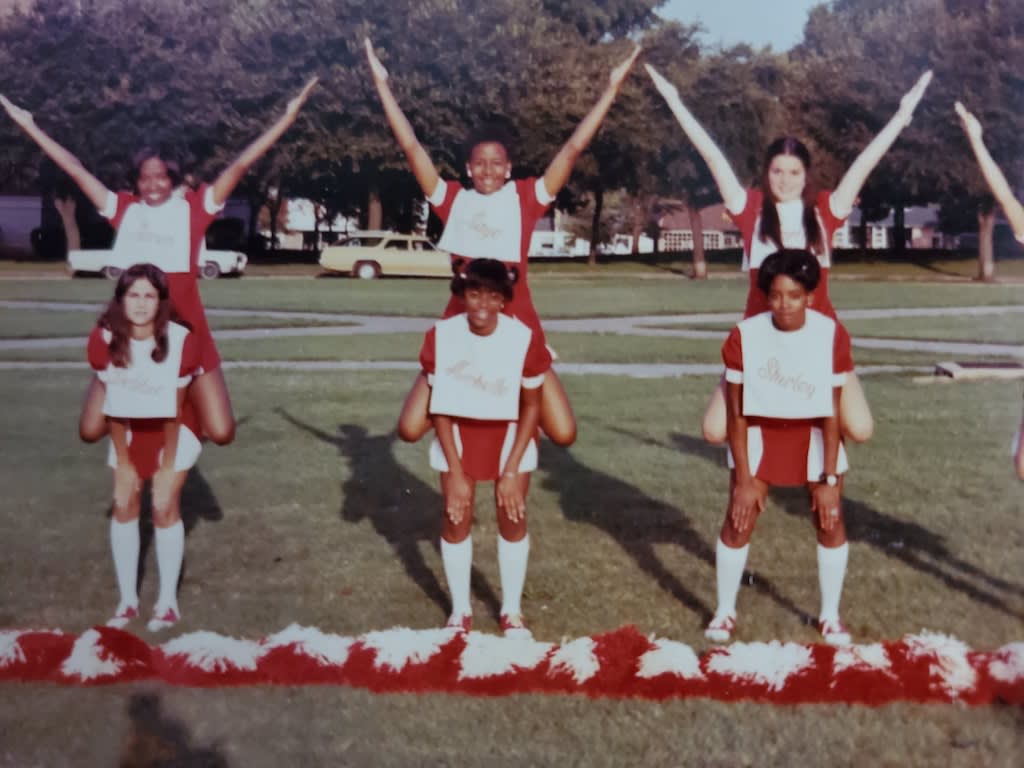BIG BONED and BLUE
How a routine school weigh-in began my lifelong battle with obesity

When students get weighed in school, it’s supposed to be done in private to spare the children any sort of embarrassment. That’s according to CDC guidelines on how schools should collect student weight data.
“Height and weight measurements must not be conducted within sight or hearing distance of other students,” the CDC states on its website. “The trained staff member conducting the measurement can be the only person to see the results and can not announce them out loud.”
I sure wish they had guidelines like this back when I was a 6th grader at Sam Houston Elementary School in Marshall, Texas. If they did, I would have been spared one of the most embarrassing occasions of my life.
Weight class
It all began during our routine end-of-the-year weight check. This one took place in May of 1970. Not only were we instructed to stand in line to wait our turn on the scale in front of our classmates, but the teacher would say our weight out loud as she recorded it in a logbook.
This was never a big deal for me in the past. But this particular year, I was in for a surprise.
I waited in line for my turn at the scale just like I had done years before – completely oblivious to the humiliation I was about to experience.
I stepped on the scale and looked straight ahead like the teacher told me. I awaited my teacher’s reading of the results. Her words landed like a loud thud.
“Michelle Petties, 135 pounds,” the teacher said matter-of-factly in front of the entire class.
Those two things – my name and my weight – spoken together in front of my classmates, left me devastated. It’s not that I hadn’t been through this routine before. It’s just that this particular year, my weight happened to be the largest in the class, even more than that of any of the boys.
I felt a sudden rush of embarrassment and self-consciousness. There was never any hiding my size. But to get a clear and scientific confirmation by way of a public announcement that – yes, I was the biggest kid in class – put me in an uncomfortable spotlight.
In years past, this annual weigh-in was just an unremarkable routine; something changed – dramatically – on this particular day. For the first time, that number – my weight – meant something and it really rattled my preteen psyche.
In search of solace
As just one of a handful of Black students in an otherwise all-white class, I didn’t know at the time – and not sure it would have made much of a difference if I did – Black girls tend to develop faster than white girls, and food – especially food without a lot of activity – is often the reason.
After school was dismissed, I rushed home distraught, anxious and upset, looking for solace from the one person in my world who always made everything alright.
“Oh, Kitten,” my grandmother said, using her pet name for me. “You’re not fat. You just have big bones.”
But this time, my grandmother’s consoling words offered zero comfort. In my distress, I knew the cold, hard, sobering truth.
Stout. Chubby. Chunky. Solid. Thick. Big girl. I had heard my grandmother and others use these words when talking about me. These words weren’t meant to be hurtful, not at all. Often the matronly ladies at Galilee Baptist Church would offer up big encouraging smiles of admiration, along with a phrase like “Ooh, chile! She sure is a healthy one,” to describe me. My grandmother would beam with pride at the compliment – the fact that I was so “healthy” a testament to the fact that she and my grandfather were doing a fine job keeping me well fed and taken care of, a weighty responsibility which they took to heart.
On that day in May a few weeks before my 12th birthday, I felt for the first time the soul piercing pain of what it meant to be uncomfortable in my own skin. Fat and happy would never be my truth. I had enough of shopping for dresses in the “stout girls” department and wearing girdles and grown folks’ hand-me-downs. Something was about to change.
Refusing food
And change, I did. It was more than my passing from elementary to junior high school; it was my own growing sense of self-determination and self-awareness. The summer between 6th and 7th grade, I just wanted to be an average weight and normal size. I didn’t want to stick out because of my body. I certainly didn’t know that summer would mark the beginning of a 40-year, lifelong battle for control over my weight. I weighed myself every day – and sometimes two or three times a day. I drowned hunger pains with glass after glass of water. I spent the entire summer battling with my grandmother over food. I would skip meals or only eat very small amounts. I would claim I wasn’t hungry or that I had already eaten.
In the past, cleaning my plate had never been that much of an issue because I had always been such a people pleaser and loved the big smiles, approval and joy that being a “good eater” brought to the faces of my grandparents. Their joy was born out of the knowledge that food was key to life and since I was born 2 months premature, they were committed to providing me – a 7-month baby, as I was often reminded – every opportunity to live and thrive. Moreover, food costs money and not eating food that someone has worked hard to prepare and put on the table was viewed as disrespectful. Sticking to my I’m-not-eating plan was especially tricky because the same sweet and loving grandmother – the one that shoved me into girdles, instructed me to “eat with my eyes” and denied me a hula hoop because I was too big – was constantly trying to get me to eat more.
Daily, I refused delicious, down-home, Southern soul food. I also stepped up my physical activity. My routine included jumping rope and some jogging. Much to my surprise my grandmother would help me by counting my jumping jacks and holding my feet while I did sit-ups. I copied some of the chair routines that Jack LaLanne – known as “The Godfather of Modern Fitness” – did on his TV program. I was careful to use the kitchen chairs and not the “good” dining room chairs. I needed to stay on my grandmother’s good side.
Anyone on the outside looking in would think I possessed unbelievable will power, rock solid self-control and unyielding determination. In reality, it was something else. I was haunted by the day my teacher announced my weight in class. Michelle Petties, 135 pounds. Michelle Petties, 135 pounds. The words reverberated inside my head. It was my single-minded mission to escape and erase the memory of those painful words.
Trim and slim
The following semester in September of 1970 – the first year of forced integration for the Marshall Independent School District – I found myself on the campus of H.B. Pemberton, Jr. High School, which was renamed as Price T. Young a few years later in 1975.
Our first day as newly-minted middle schoolers, we all wandered the halls in search of our respective homerooms. Girls stepped out in freshly pressed dresses; boys squirmed in crisp shirts and stiff jeans. Me? I was ready, greased down with Vaseline, wearing brand new, brown patent leather penny loafers, hair freshly pressed and curled and proudly donned in my first day of school ensemble. Finally, after a five-year separation, I would be reunited with my Dunbar classmates. I stepped through the doors of my new school confidently, no longer burdened by the weight of being the biggest one my class. I had successfully shed 13 pounds to get down to 122.
Looking back, I’m glad that my school was required to keep tabs on our weight. We can't fix that which we never face. And whether it's faced publicly or privately, obesity in children as well as adults – must be faced. If it weren’t for that 6th grade weigh-in, I might have continued to add on the pounds and never take any action to slim down.

At the same time, we – that is, teachers, parents and guardians – can help children proactively stay in shape or slim down in a more compassionate manner. When it comes to diet, nutrition and exercise, we shouldn’t force them to come up with answers – and potentially the wrong answers – on their own after they’ve been publicly weighed and, in my case, fat-shamed in front of their classmates and peers.
I successfully dumped the extra weight and maintained an average weight all throughout middle and high school – and even made the cheerleading squad. And, in later years, I discovered – much to my surprise and contrary to what my grandmother told me – that I don’t have big bones after all.
About the Creator
Michelle Petties
We all have unique stories that lead us. I speak to organizations, large and small, sharing unique perspectives and my story of hope, healing, and triumph. Need an engaging, thought-provoking, and transformative speaker? Ping me.







Comments
There are no comments for this story
Be the first to respond and start the conversation.